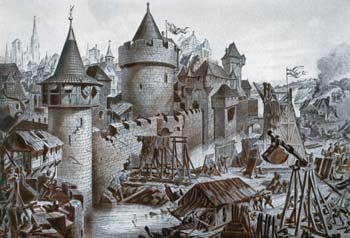 |
 |
| current issue |  |
past issues |  |
send a letter/news |  |
address update |  |
advertise |  |
about us |  |
alumni home |
Campus Currents
Class Warfare, With Lofty GoalsBy Robert Emro

|
It's a cold, gray December day and several teams have taken the field, ready for battle. But while their weapons of war may have Medieval origins, it's not conquest but accuracy and distance they're after. Whose miniature ballista, trebuchet, catapult or mangonel will fling a golf ball the farthest across Boulder Field?
Engineers in training, these students from ME 627, a mechanical engineering class popularly known as Dynamics, were given the assignment to spend no more than $50 on materials and create a small version of a siege engine. Students scrounged parts wherever they could, ˆ la the Learning Channel's "Junkyard Wars."
Now, on the day of reckoning, there's an air of excitement and a lot of joking as the teams set up their mini war machines.
Team Ski-doo Ski, clad in matching black and yellow jackets borrowed from senior captain Chris Anderson's Ski-doo racing team, has used a spring from a wood chipper and a winch from a boat trailer on its catapult. They considered, but rejected, a pull cord from a chain saw.
Team Ski-doo Ski, clad in matching black and yellow jackets borrowed from senior captain Chris Anderson's Ski-doo racing team, has used a spring from a wood chipper and a winch from a boat trailer on its catapult. They considered, but rejected, a pull cord from a chain saw.
 Once more into the breach: Students taking Mechanical Engineering 627 test their war machines on Boulder Field.
Once more into the breach: Students taking Mechanical Engineering 627 test their war machines on Boulder Field.
|
Giddy from an all-nighter spent refining their design, this team, like most of the others, has been relying heavily on trial and error. But 30 percent of their grade will be based on analysis, so they will later reverse-engineer their creation to determine why certain elements succeeded or failed.
Mike Rayno '05 and his teammates built a mangonel, which derives its power not from a counterweight, like a trebuchet, but from the elastic properties of rope. Their entry, complete with decorative blue wildcat cutouts, used aircraft landing-gear cord and an aluminum throwing arm. When the frame kept ripping apart during testing, they did some calculations. "We found that we were at 95 percent of the yielding strength of the arm," Rayno explains.
Another team chose a design inspired by the crossbow-powered rock hurler the Romans called petraria arcatinus. The winning entry for distance, however, was a scorpion, named after an ancient Roman design. Its first attempt was measured at 430 feet; its second ball was never found. Using a metal frame from a weight bench, a garage door spring and "lots of fabricated pieces," the students spent about 75 hours each building the contraption, says team captain Josh Lent '05. During the competition, a student from another team was overheard saying, "You could totally sell that thing on eBay."
The project is a good way to teach some of the course's concepts, like rigid-body dynamics, work-energy relationships, rectilinear and curvilinear motion, and momentum and impulse principles, says lecturer Jindrich Novak '04G, who taught the course this year while professor Igor Tsukrov is on sabbatical. "It's not just theory; it's fun."
Easy to print version
blog comments powered by Disqus

